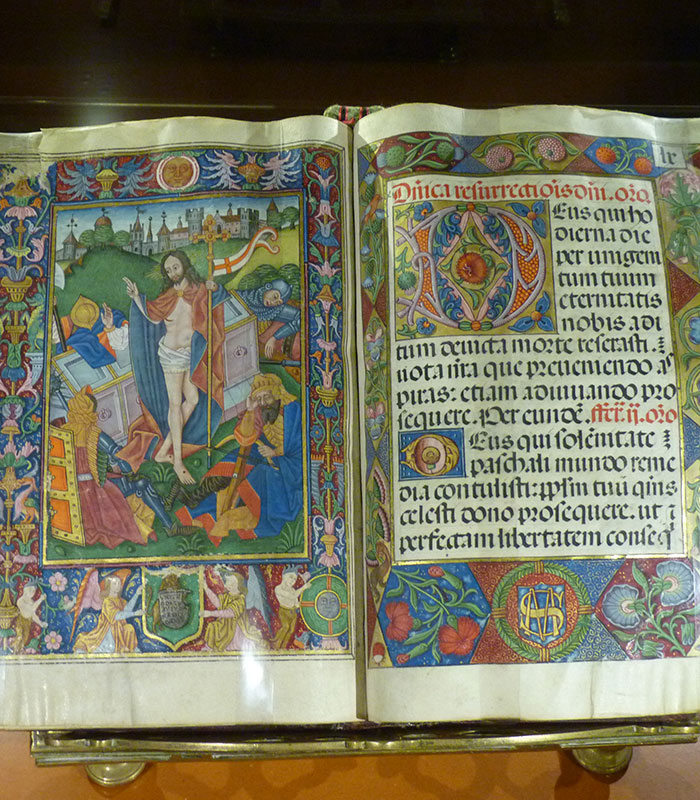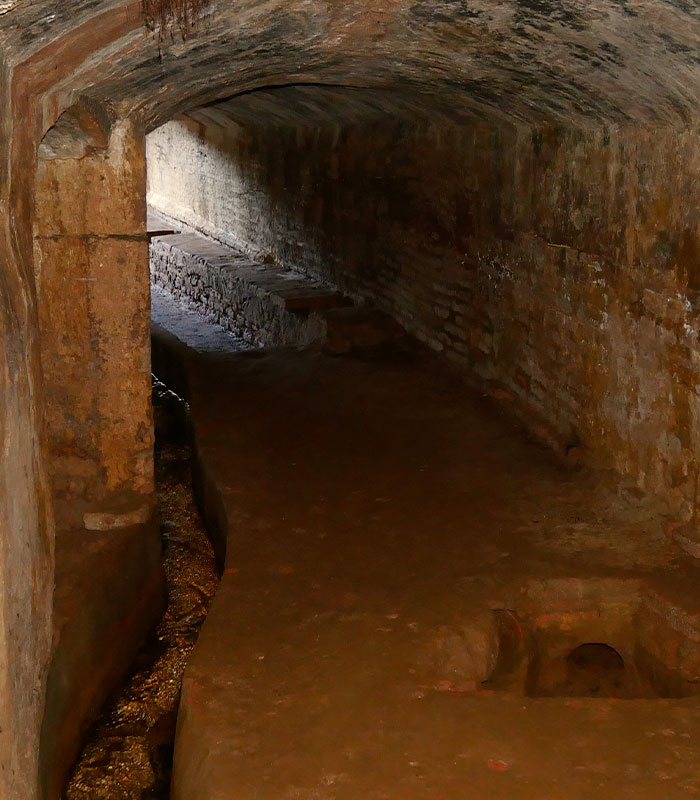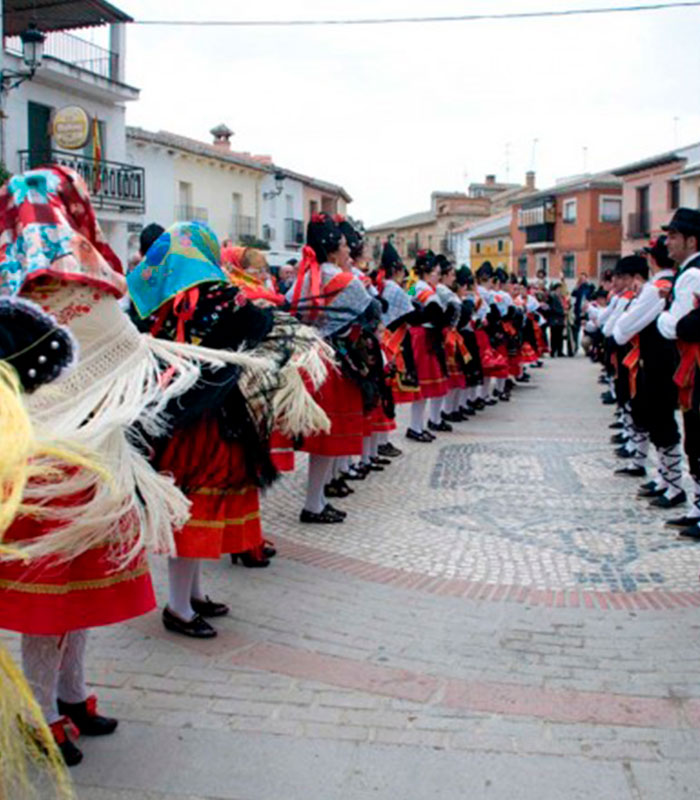01-THE PALAEOLITHIC RECORD OF THE RAÑAS OF ALÍA, LOGROSÁN, AND CAÑAMERO
The rañas of Alía, Logrosán, and Cañamero constitute raised areas in the form of a tableland and are an important site at which human presence has been confirmed since the [...]
02-SCHEMATIC PAINTINGS AND ROCK ENGRAVINGS
The area included in the Villuercas-Ibores-Jara Global Geopark of the UNESCO holds an important example of so-called Iberian schematic art, the age of which goes back four thousand years. To [...]
03-THE CUEVA DE LA CHIQUITA OR CUEVA DE ÁLVAREZ
Alongside the River Ruecas near the Charco de la Nutria, surrounded by vegetation and in a rugged defile, can be found a shelter adorned by numerous cave paintings which is [...]
04-THE RISQUILLO DE PAULINO
The shelter which houses these paintings takes its name from its discoverer, Paulino Tejero Aparicio of Berzocana. It is surrounded by oak and chestnut woodland on a small promontory on [...]
05-THE CANCHO DEL RELOJ OF SOLANA DE CABAÑAS
Since ancient times this crag has been known locally as the Cancho del Reloj (Clock Rock) as it is the first to be lit up by the sun's rays every [...]
06-DOLMENS
Megaliths are monuments constructed from large stones, which is what the name means. In the Villuercas-Ibores-Jara Global Geopark of the UNESCO dolmens are good examples of these, in particular that [...]
07-THE DECORATED STELAE OF CABAÑAS DEL CASTILLO AND SOLANA DE CABAÑAS
If there is a genuine Bronze Age element in the southwest of the Iberian Peninsula, it is the so-called "decorated stelae". Fashioned in blocks of stone of up to 2.30 [...]
08-THE FORTIFIED SETTLEMENTS
The fortified settlements of Aldeacentenera, Berzocana, Retamosa, and Fresnedoso de Ibor are good examples of the native cultures of the Iberian Peninsula. Located in some of the most strategic sites [...]
09-THE ZOOMORPHIC SCULPTURES OF VETTON ORIGIN
Verracos (animal figures sculptured in stone) are to be found in the Villuercas-Ibores-Jara Global Geopark of the UNESCO in the form of the noteworthy examples which can be observed in [...]
10-THE TREASURE OF BERZOCANA
In April 1961 the goatherd Domingo Sánchez of fourteen years of age was passing with his flock through the estate of Los Machos, about three kilometres from Berzocana. In the [...]
11- MINE SITES OF SAN CRISTOBAL HILL
The rañas of Alía, Logrosán, and Cañamero constitute raised areas in the form of a tableland and are an important site at which human presence has been confirmed since the [...]
12-ROMAN MINING
The subsoil of the Villuercas-Ibores-Jara Global Geopark of the UNESCO conceals rich mining resources which since antiquity have attracted the attention of the various peoples who inhabited this territory. However, [...]
13- ROMAN AND VISIGOTHIC REMAINS
Both Romans and Visigoths also left their mark on the territory of the Villuercas-Ibores-Jara Global Geopark of the UNESCO. Although no major remains are present, it is however true that [...]
14-THE CASTLES OF MOSLEM ORIGIN AND THEIR SETTLEMENTS
During virtually the whole of the Middle Ages, Extremadura was an eminently frontier land. This led to intense warfare and frequent border changes. Witnesses of that time are the numerous [...]
15-THE CASTLE OF CABAÑAS
For almost a millennium there has been a Moslem fortress above the village of Cabañas del Castillo on one of the impressive vertical walls of the western area of Las [...]
16-THE FUERTE DE CASTROS OF VILLAR DEL PEDROSO
During the Córdoba caliphate a series of defensive structures were raised for the purpose of halting the Christian advance south of the River Tajo. This strip of territory was called [...]
17-THE MEDIEVAL ROUTES OF GUADALUPE
For centuries members of royalty, the nobility, the clergy, and merchants and pilgrims travelled to the Real Monasterio de Santa María de Guadalupe from all points of Castile. Ever since [...]
18-THE CHURCH OF SANTA CATALINA OF ALÍA
In the village of Alía stands what is probably the finest manifestation of Mudejar religious art of Extremadura. The Church of Santa Catalina, in effect, is a magnificent example of [...]
19-THE CHAPEL OF OUR LADY OF BELÉN OF CAÑAMERO
This chapel holds the patron of the village, the Virgen de Belén. She can be found some three kilometres from the built-up area alongside the River Ruecas, surrounded by quartzite [...]
20-THE CHURCH OF OUR LADY OF LA PEÑA OF CABAÑAS DEL CASTILLO
We are at the foot of one of the best viewpoints of the Villuercas-Ibores-Jara Global Geopark of the UNESCO: the wall of granite on which rises the Arab castle, later [...]
21-THE CHURCH OF SAN JUAN BAUTISTA OF BERZOCANA
According to legend, in 1223 a farmer found a marble sarcophagus in an olive grove. Inside laid the remains of San Fulgencio and Santa Florentina, 6th-century saints of Visigothic origin [...]
22-THE CHURCH OF SAN MATEO OF LOGROSÁN
The Church of San Mateo de Logrosán is one of the best examples of Gothic religious architecture of the Villuercas-Ibores-Jara Global Geopark of the UNESCO. This is so to such [...]
23-THE CHURCH OF SAN PEDRO DE VILLAR DEL PEDROSO
We are at the foot of one of the best viewpoints of the Villuercas-Ibores-Jara Global Geopark of the UNESCO: the wall of granite on which rises the Arab castle, later [...]
24-THE PILLORIES OF THE TOWNS
Several villages of the Villuercas-Ibores-Jara Global Geopark of the UNESCO, such as Logrosán, Deleitosa, and Cabañas del Castillo, still retain a highly characteristic type of monument which takes us back [...]
25-THE STATIONS OF THE CROSS OR PERALEDA DE SAN ROMÁN AND VALDELACASA DE TAJO
The stations of the cross of Peraleda de San Román and Valdelacasa de Tajo are good examples of devotional monuments of Castilian tradition. Around them religious events were celebrated for [...]
26-THE TRADITIONAL ARCHITECTURE OF LA JARA
Within the Villuercas-Ibores-Jara Global Geopark of the UNESCO, La Jara has preserved over time its traditional architecture which has an unmistakeable personality. Even today it is still possible to find [...]
27-THE DROP HAMMER AND THE ACUEDUCTO DE LAS HERRERÍAS OF CAMPILLO DE DELEITOSA
This tremendous work of hydraulic engineering in the valley of the River Descuernacabras in the vicinity of Campillo de Deleitosa, hidden in the heart of the Villuercas-Ibores-Jara Global Geopark of [...]
28-THE REAL MONASTERIO DE SANTA MARÍA DE GUADALUPE
Situated in the heart of Las Villuercas, the Real Monasterio de Santa María de Guadalupe is unique in many respects. Its construction began in the 13th century and continued for [...]
29-THE TOWN OF GUADALUPE
The town of Guadalupe originated and grew up around the Real Monasterio, taking its name from the river where the image of the Virgin appeared. But Guadalupe, declared a Historical-Artistic [...]
30-THE MUSEUMS OF THE MONASTERIO DE GUADALUPE
For centuries the Marian devotion of which Guadalupe was the centre of attraction, together with the importance given to it by noblemen and kings, meant that between the walls of [...]
31-The Mudejar Shrine of Guadalupe
As if it were protecting a precious jewel, the Mudejar cloister of the Real Monasterio de Santa María de Guadalupe envelops and watches over one of the most important architectural [...]
32-THE PALACE OF THE GRANJA DE MIRABEL
In the foothills of La Villuerca, between two valleys and surrounded by leafy chestnut woodland, stands the Granja de Mirabel, a palace chosen by the Catholic Monarchs in which to [...]
33-THE GRANJA DE VALDEFUENTES
The Granja de Valdefuentes, a royal and Hieronymite residence, is almost hidden in the woods near Guadalupe. With the aspirations of a palace, albeit with the dimensions of a country [...]
34-THE CHAPEL OF EL HUMILLADERO
The trials and tribulations of the way are forgotten in the joy of reaching this point, which is about four kilometres from the town of Guadalupe. For some fatigue turns [...]
35-THE POZO DE LA NIEVE OF GUADALUPE
Having ice available all year round was a major challenge for our ancestors. The outstanding construction of the Pozo de la Nieve (Snow Well) demonstrates not only the engineering efforts [...]
36-THE ARCA DEL AGUA
The Arca del Agua is one of the most valuable engineering legacies of all the works of the Hieronymites scattered over the Villuercas-Ibores-Jara Global Geopark of the UNESCO. With the [...]
37-THE MILLS, WATER MILLS, DROP HAMMERS, AND FULLING MILLS OF THE GUADALUPEJO
Along its course the River Guadalupejo had a large number of hydraulic works, most of which are directly linked to the history of the Real Monasterio and the town of [...]
38-THE HISPANIDAD FESTIVAL
Since 1929 the Virgin of Guadalupe has held the title of Queen of La Hispanidad. This means that every year on 12th October, the anniversary of the arrival of the [...]
39-THE FESTIVAL OF THE VIRGEN DE GUADALUPE
8th September is one of the most important dates for the town of Guadalupe. This is the day on which the religious festival of the Virgen de Guadalupe, the patron [...]
40-THE CARNAVAL DE ÁNIMAS OF VILLAR DEL PEDROSO
The Carnaval de Ánimas of Villar del Pedroso is not a fancy-dress party. It has little to do with the most colouristic manifestations of Shrovetide. It is an ancient and [...]
41-THE PHOTOGRAPHIC LEGACY OF EUGENE SMITH IN DELEITOSA
In 1950 the prominent American photographer Eugene Smith arrived in Spain to report on the ‘prolonged drought’ of the country. One of the most famous international reporters explored with his [...]
42-The Viaduct of Guadalupe
In the 1920s a railway line was approved which was to connect Badajoz, Madrid, and Huelva via Villanueva de la Serena and Talavera de la Reina. The wild foothills of [...]
43-The Interpretation Centre of Local Archaeology
The replica of a cave with cave paintings and the reproduction of several of the pieces of what is known as the Bronze-Age Treasure of Berzocana are some of the [...]
44-The Intangible Heritage
Beyond the richness of the physical heritage which the passage of the centuries has left us in the form of churches, fortresses, civil engineering, monuments, and other places with cultural, [...]










































